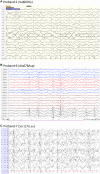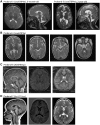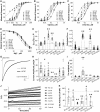Heterogeneous clinical and functional features of GRIN2D-related developmental and epileptic encephalopathy
- PMID: 31504254
- PMCID: PMC6763743
- DOI: 10.1093/brain/awz232
Heterogeneous clinical and functional features of GRIN2D-related developmental and epileptic encephalopathy
Abstract
N-methyl d-aspartate receptors are ligand-gated ionotropic receptors mediating a slow, calcium-permeable component of excitatory synaptic transmission in the CNS. Variants in genes encoding NMDAR subunits have been associated with a spectrum of neurodevelopmental disorders. Here we report six novel GRIN2D variants and one previously-described disease-associated GRIN2D variant in two patients with developmental and epileptic encephalopathy. GRIN2D encodes for the GluN2D subunit protein; the GluN2D amino acids affected by the variants in this report are located in the pre-M1 helix, transmembrane domain M3, and the intracellular carboxyl terminal domain. Functional analysis in vitro reveals that all six variants decreased receptor surface expression, which may underline some shared clinical symptoms. In addition the GluN2D(Leu670Phe), (Ala675Thr) and (Ala678Asp) substitutions confer significantly enhanced agonist potency, and/or increased channel open probability, while the GluN2D(Ser573Phe), (Ser1271Phe) and (Arg1313Trp) substitutions result in a mild increase of agonist potency, reduced sensitivity to endogenous protons, and decreased channel open probability. The GluN2D(Ser573Phe), (Ala675Thr), and (Ala678Asp) substitutions significantly decrease current amplitude, consistent with reduced surface expression. The GluN2D(Leu670Phe) variant slows current response deactivation time course and increased charge transfer. GluN2D(Ala678Asp) transfection significantly decreased cell viability of rat cultured cortical neurons. In addition, we evaluated a set of FDA-approved NMDAR channel blockers to rescue functional changes of mutant receptors. This work suggests the complexity of the pathological mechanisms of GRIN2D-mediated developmental and epileptic encephalopathy, as well as the potential benefit of precision medicine.
Keywords: GluN; NMDA receptor; channelopathy; functional genomics; glutamate receptor.
© The Author(s) (2019). Published by Oxford University Press on behalf of the Guarantors of Brain. All rights reserved. For Permissions, please email: journals.permissions@oup.com.
Figures






Similar articles
-
GRIN2D/GluN2D NMDA receptor: Unique features and its contribution to pediatric developmental and epileptic encephalopathy.Eur J Paediatr Neurol. 2020 Jan;24:89-99. doi: 10.1016/j.ejpn.2019.12.007. Epub 2019 Dec 18. Eur J Paediatr Neurol. 2020. PMID: 31918992 Free PMC article. Review.
-
GRIN2D Recurrent De Novo Dominant Mutation Causes a Severe Epileptic Encephalopathy Treatable with NMDA Receptor Channel Blockers.Am J Hum Genet. 2016 Oct 6;99(4):802-816. doi: 10.1016/j.ajhg.2016.07.013. Epub 2016 Sep 8. Am J Hum Genet. 2016. PMID: 27616483 Free PMC article.
-
Molecular Mechanism of Disease-Associated Mutations in the Pre-M1 Helix of NMDA Receptors and Potential Rescue Pharmacology.PLoS Genet. 2017 Jan 17;13(1):e1006536. doi: 10.1371/journal.pgen.1006536. eCollection 2017 Jan. PLoS Genet. 2017. PMID: 28095420 Free PMC article.
-
GluN1 splice variant control of GluN1/GluN2D NMDA receptors.J Physiol. 2012 Aug 15;590(16):3857-75. doi: 10.1113/jphysiol.2012.234062. Epub 2012 May 28. J Physiol. 2012. PMID: 22641781 Free PMC article.
-
Perampanel therapy for intractable GRIN2D-related developmental and epileptic encephalopathy: A case report and literature review.Brain Dev. 2023 Apr;45(4):237-243. doi: 10.1016/j.braindev.2022.12.001. Epub 2022 Dec 24. Brain Dev. 2023. PMID: 36567197 Review.
Cited by
-
De novo GRIN variants in NMDA receptor M2 channel pore-forming loop are associated with neurological diseases.Hum Mutat. 2019 Dec;40(12):2393-2413. doi: 10.1002/humu.23895. Epub 2019 Sep 10. Hum Mutat. 2019. PMID: 31429998 Free PMC article.
-
Synaptic Dysfunction by Mutations in GRIN2B: Influence of Triheteromeric NMDA Receptors on Gain-of-Function and Loss-of-Function Mutant Classification.Brain Sci. 2022 Jun 15;12(6):789. doi: 10.3390/brainsci12060789. Brain Sci. 2022. PMID: 35741674 Free PMC article.
-
A de novo GRIN1 Variant Associated With Myoclonus and Developmental Delay: From Molecular Mechanism to Rescue Pharmacology.Front Genet. 2021 Aug 3;12:694312. doi: 10.3389/fgene.2021.694312. eCollection 2021. Front Genet. 2021. PMID: 34413877 Free PMC article.
-
GRIN2D/GluN2D NMDA receptor: Unique features and its contribution to pediatric developmental and epileptic encephalopathy.Eur J Paediatr Neurol. 2020 Jan;24:89-99. doi: 10.1016/j.ejpn.2019.12.007. Epub 2019 Dec 18. Eur J Paediatr Neurol. 2020. PMID: 31918992 Free PMC article. Review.
-
Spectrum of NMDA Receptor Variants in Neurodevelopmental Disorders and Epilepsy.Methods Mol Biol. 2024;2799:1-11. doi: 10.1007/978-1-0716-3830-9_1. Methods Mol Biol. 2024. PMID: 38727899 Review.
References
-
- Aras MA, Hartnett KA, Aizenman E. Assessment of cell viability in primary neuronal cultures. Curr Protoc Neurosci 2008; 44: 7.18.1–7.18.15. - PubMed
-
- Burnashev N, Szepetowski P. NMDA receptor subunit mutations in neurodevelopmental disorders. Curr Opin Pharmacol 2015; 20: 73–82. - PubMed
-
- Chez MG, Burton Q, Dowling T et al. . Memantine as adjunctive therapy in children diagnosed with autistic spectrum disorders: an observation of initial clinical response and maintenance tolerability. J Child Neurol 2007; 22: 574–9. - PubMed
Publication types
MeSH terms
Substances
Grants and funding
LinkOut - more resources
Full Text Sources
Molecular Biology Databases

